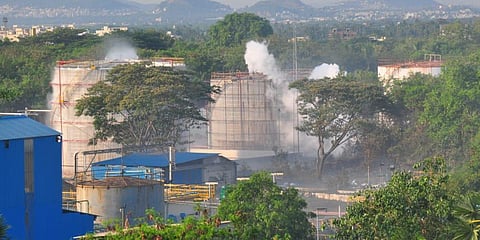

VISAKHAPATNAM: The LG Polymers plant at Venkatapuram turned into a beehive of restoration work on Friday, a day after a gas leak from it suffocated humans and animals alike, killing some of them and leaving hundreds hospitalised.
The toll due to the mishap rose to 12, with the body of a 64-year-old being found at S Kota. The deceased had driven there in a bid to escape the deadly styrene fumes. At the KGH mortuary, heart-wrenching scenes played out as people gathered after hearing in the news that their relatives had died.
Work on plugging the gas leak is being undertaken by a seven-member core team from LG Polymers, and a nine-member expert team that arrived late on Thursday. The leak was caused as temperature in the tank, storing styrene (which exists as a liquid when stored below 20 degrees Celsius) at the plant, reached 180 degree Celsius.
The vapourised styrene then passed through the safety valve. On Friday, the temperature was brought down to 120 degree Celsius. The tank storing it will be declared safe only after the temperature is brought below 100 degree Celsius.
However, the teams are finding it difficult to do this, a top official of the factories department told TNIE, adding that as the liquid cannot be taken out of the tank, they are polymerising the styrene and adding NBM as a catalyst.
With the top portion polymerised and the bottom portion in liquid form, they have to maintain viscosity and regulate the temperature to polymerise the remaining styrene.
PTBC is being added as an inhibitor to control the emanation of vapour.
So far, 50 per cent of the 18,000 tonnes of styrene in the tank has polymerised. The tank will be abandoned once its contents have entirely been polymerised in solid form.
Had the vapour been locked in the tank, if the safety valve failed to open on Thursday, an explosion would have ensued.
The styrene should have been utilised instead of being stored for so long, and this caused the problem as the increase in pressure led to a rise in temperature, said a chemical engineer who spoke on condition of anonymity. The plant should have been allowed to operate till the styrene was used up, the engineer opined.
In the villages around the plant, NDRF, SDRF and police personnel maintained vigil, and won widespread appreciation for risking their lives to save the locals.
Madhu Babu, an SDRF personnel, said they were shocked to see people falling unconscious.
He recalled that they encountered poor visibility and suffered irritation and shortness of breath. To overcome the discomfort, they went in batches to rescue people.EDIT: